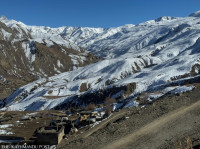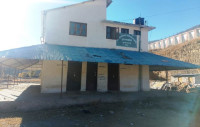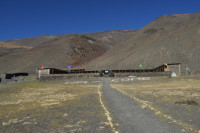Karnali Province
Mugu-Humla link road renews hopes of easier life for rural folks
The new link road has replaced the foot trail connecting Humla to the rest of the country through Mugu.
Bidhya Rai & Raj Bahadur Shahi
Maya Devi Shahi from Rimi village in Humla recalls the time she would walk for five days to Simikot, the district headquarters, to buy rice. Come rain or shine, the 35-year-old made the journey at least once a month to feed her family of five.
“Like so many others from my village, I used to walk for days on an empty stomach to buy the daily essentials,” said Maya Devi. “We never thought we would see an end to those hard times.”
But now that the 67-kilometre Mugu-Humla link road has come into operation, Shahi says she can finally give herself a rest from her monthly journeys.
The newly-built link road has replaced the foot trail connecting Humla to the rest of the country through Mugu. “The dirt road has become motorable which means goods can now be directly transported to the villages,” Shahi said.
The link road was constructed under the Rural Access Programme 3 (RAP3), a government programme funded by UK Aid, with the assistance of Rs1.6 billion from the British government.
The road is one of Nepal’s longest built with the help of the British government. Situated at an elevation of 3,300 metres above sea level, the 67-km road stretch is 4.5 metres wide. The road was upgraded on a four km section from Gamgadhi to Karnali river in Mugu. From there, a 63-km new road was constructed through Chhayanath Rara municipality of Mugu to Chankheli Rural Municipality of Humla. Thirty-seven km of the road stretch is in Mugu while 30 km falls in Humla. Motorable bridges have been built across four rivers.
Although the construction work was completed last June, British Ambassador Nicola Pollitt handed over the road to the Chief Minister of Karnali Province Jeevan Bahadur Shahi only on December 21.
The operation of the dirt road has brought much relief to the locals of Humla and Mugu. Earlier, the locals of Chankheli Rural Municipality had to walk for three days to reach Simikot, the district headquarters, and two days to reach Gamgadhi, the district headquarters of the neighbouring district of Mugu. The return journey would take twice as long. Residents of the rural municipality go to Simikot for administrative work while they prefer going to Gamgadhi to purchase daily essentials since it is closer.
Humla and Mugu, two districts in Karnali Province that are Nepal’s remotest, face food shortages every year since the geography of the region is not conducive to agriculture. The vast swathes of land are covered in infertile soil and rocky surface, and do not support farming on a large scale.
According to the Multidimensional Poverty Index Report of the National Planning Commission released last year, among the seven provinces, Karnali has the highest poverty rate, with more than 39.5 percent of people there under the poverty line.
The indigenous crops grown by the residents of Humla and Mugu are not even enough to sustain them for around six months.
“We had to ration food so that our stock could last us longer. I used to eat only one meal a day because three months after harvest, we would be left with nothing to eat,” Danpati Budha of Rima village told the Post. “We would pay thrice the market price for food grain if we wanted it to be transported on mules by traders. Mule traders charge Rs30 per kg to transport rice from Gamgadhi to Rima. Now we pay tractors Rs10 per kg. To save money, poor people like us used to walk for weeks carrying the rice sacks on our backs.”
According to the record of the RAP3 programme, after the operation of the Mugu-Humla link road, food prices have decreased by 43 percent in the two districts.
Similarly, Chandra Bahadur Budha, a 50-year-old from Chhayanath Rara Municipality-14 in Mugu, says the operation of the link road has filled people with hope. “We never thought we would get access to good roads. Today when I see vehicles plying these rural roads, I feel happy,” he said. “The construction of the road also gave villagers employment. Due to the pandemic, people returned to the villages after losing their jobs in the cities. The link road construction gave these people jobs and a means to provide for their families.”
During the construction of the link from mid-November 2018 to mid-June 2022, more than 4,400 locals were employed by the project and more than 35 percent of them were women.
“The good part of this project was that women and men got equal wages, which rarely happens. This project also gave women the opportunity to earn along with the taste of freedom that comes with financial independence,” said Bir Bahadur Khadka, ward chairman of Chhayanath Rara Municipality ward 13.
According to RAP records, each worker earned more than Rs800,000 throughout the duration of the project.
Dhanapati Budha, another local of Rimi, who has a family of ten, says while he would usually go to India to look for jobs, after the culmination of the project he decided to stay back and become a farmer.
“Earlier I would go to India in search of jobs at construction sites or to work as a security guard. But this time I made enough money working in the construction of the link road. I have decided to invest the money in agriculture and make a living out of it,” said Dhanapati.
The road connectivity gave Dhanapati the courage to start from scratch. “We can grow seasonal crops and take them to the markets. Ease of transportation has made business possible for us,” he said.
However, since the link road is yet to be blacktopped, the locals are worried about its condition during the rainy season.
“I request the government to blacktop the road before the monsoon starts because, in its existing condition, the road will become unmotorable by then,” said Dhanapati.
Simikot, the headquarters of Humla, is still not connected to the national road network and there are hardly any blacktopped roads in Mugu. Monsoon brings all transportation to a halt in both these districts.
Gora Bahadur Bohora, a 59-year-old man from Humla’s Bohorawada in Chankheli Municipality, says that even though the link road has come as a boon to the rural population of Humla and Mugu, the authorities now must start blacktopping work on the road. “During medical emergencies, it becomes a challenge to take patients to the hospital. The road will become unmotorable and patients will have to suffer,” he said. “Helicopter rescues also become impossible during the monsoon. Last year during the monsoon, a helicopter came to medivacuate a pregnant woman but it couldn’t land. It took a while before they could rescue the pregnant woman and take her to a hospital.”
Gyani Shahi, a resident of Chhayanath Rara Municipality-1 who owns a small business, said that the suffering of locals who were forced to walk for weeks or starve to death is now over. “Back then, only a few people used to buy goods from my shop because it was three times more costly than the actual price because of the transportation charge. The goods used to get so expensive that only a very few could afford them,” said Gyani. “On the other hand, seasonal fruits and vegetables grown here would go to waste for lack of transportation. Now the local farmers are enthused about the possibilities of trade.”
The construction of the road has also contributed to an uptick in tourist arrivals in the area. The number of tourists coming to visit the Chankhel mountain area has been increasing gradually after the operation of the Gamgadi to Daram road section, according to Jun Bahadur Baduwal, ward chair of Chhayanath Rara Municipality ward 14. “We hope this will help us transform the area into a tourist destination which will generate income opportunities for rural people,” Baduwal said.
As for Maya Devi from Rima village, seeing a four-wheeler driving right to her village still feels unreal. “All the goods are now being transported directly to our homes,” she said. “I still can’t believe I no longer have to cross valleys and hills for a packet of salt.”




 16.12°C Kathmandu
16.12°C Kathmandu
.jpg)










